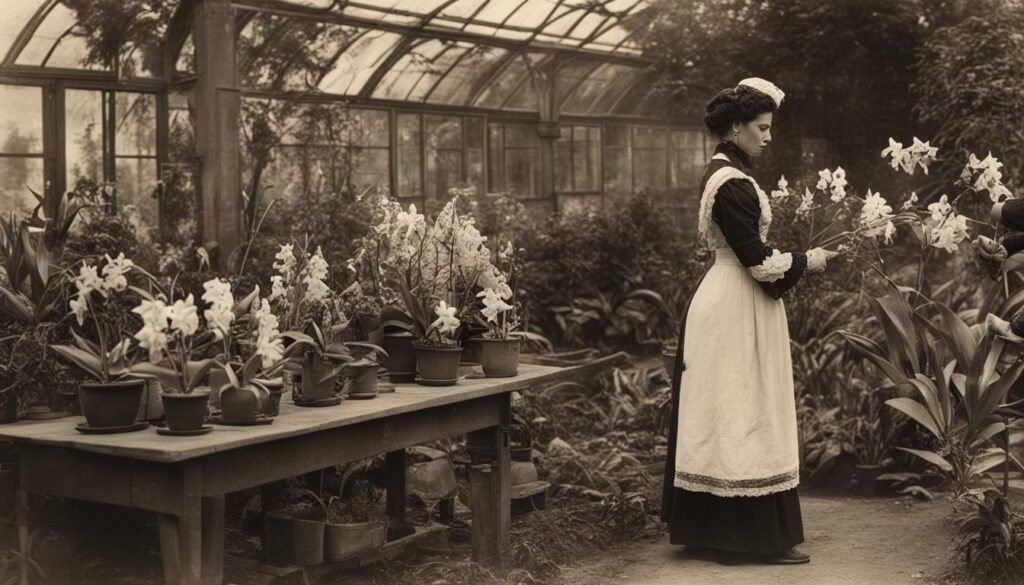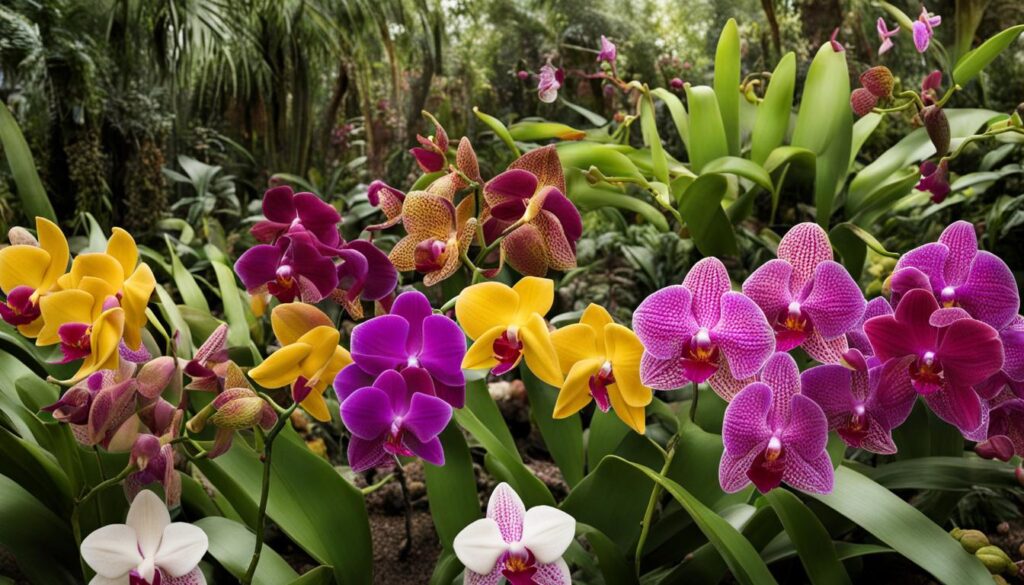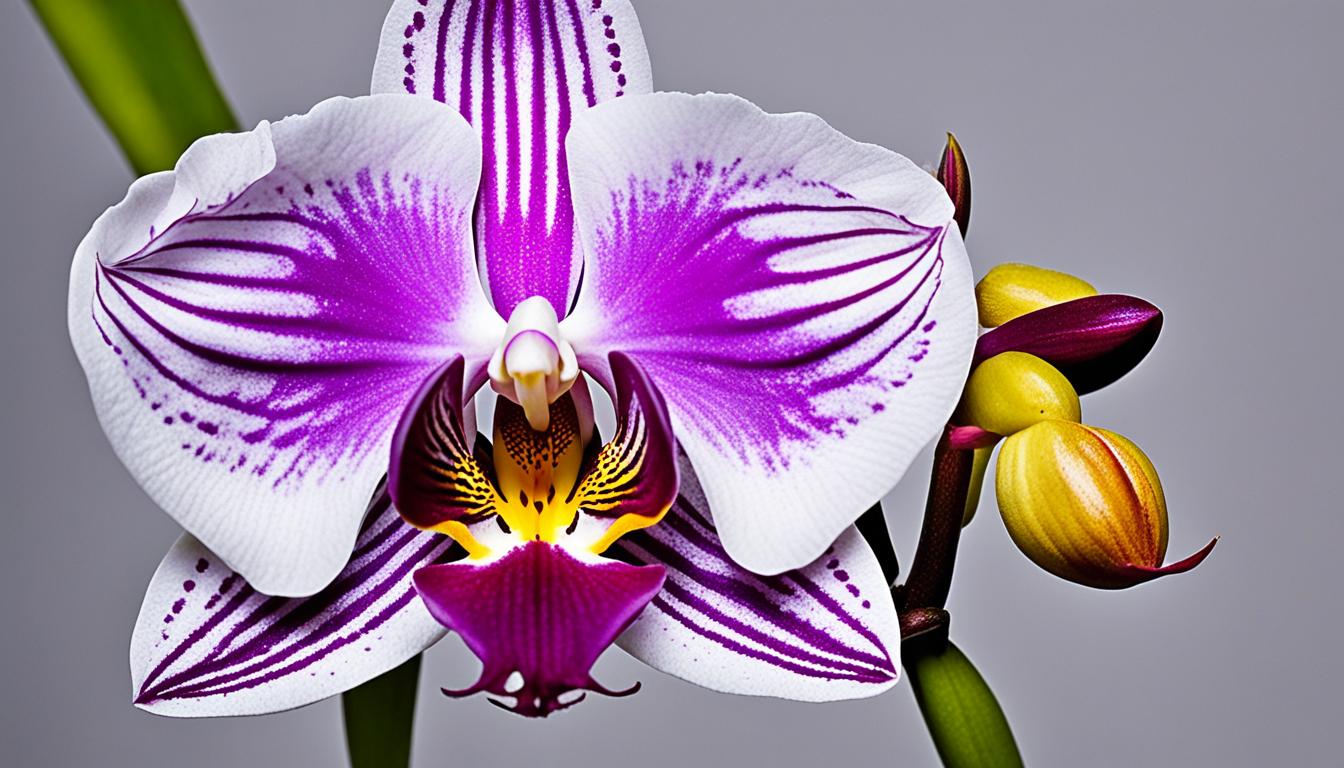Did you know that there are over 100,000 registered orchid hybrids, and the number keeps growing every year?
Orchid hybridization isn’t just for scientists; it’s something I, and even you, can do at home. I’ll walk you through the orchid breeding basics, making it simple to dive into the world of hybrid orchids creation.
Imagine mixing together different orchids like combining flavors in a kitchen, coming up with all sorts of new and wonderful bloom varieties.
All you need is a bit of patience and space for your new orchid babies to grow.
Creating your own orchid hybrids can be a rewarding hobby. You take pollen from one orchid and move it to another, working with the natural design of these plants.
I’ll share with you a straightforward orchid hybridization guide that even beginners can follow. It’s not just about creating beautiful flowers; it’s about the joy of experimenting and watching as new life takes shape because of your efforts.
Key Takeaways
- Orchid hybridization is a growing hobby with over 100,000 hybrids already.
- Anyone with interest can create hybrid orchids by understanding simple orchid breeding basics.
- The process involves cross-pollinating two different orchids to produce new varieties.
- Hybrid orchids tend to be more accessible and affordable for growers.
- Creating orchid hybrids is like experimenting with flavors to discover new combinations.
- Success in orchid hybridization requires patience and proper space for seedlings.
What Is Orchid Hybridization
Imagine if we could mix and match the finest traits of orchids like a painter mixes colors – this is what orchid hybridization is all about. It’s the art and science of crossing different orchid species or varieties to create a new, unique hybrid orchid.
This process takes advantage of the remarkable diversity in the orchid family and the complex beauty of orchid genetics.
Hybridizing orchids is a way to bring out the best in these plants. Through orchid crossbreeding, growers aim to combine desirable characteristics such as vibrant colors, interesting patterns, and resilience to certain environments.
These hybrids are not just happenstance; they’re the result of careful planning and understanding of how orchid traits are passed down.
Defining Orchid Hybrids
An orchid hybrid is like a botanical blend, a mash-up of the parent plants’ best features. When two different orchids are crossbred, the offspring inherits genes from both parents.
This means hybrids can have a mix of colors, shapes, and sizes that may not exist in nature.
Hybrids are important because they can be tougher than their parents, making them better suited for different growing conditions.
Plus, they often have a unique charm and charisma all their own, thanks to the combination of traits they’ve inherited.
Types of Orchid Hybrids
There are mainly two types of hybrids, those that are crossed within the same species, and those that are crossed between different species or even genera, known as intergeneric hybrids.
With over 25,000 orchid species out there, can you imagine the possibilities? I mean, we’re talking about an almost endless mix-and-match game.
Orchid hybridizers get to play matchmaker, choosing which orchids to cross to bring new, exciting varieties into the world.
To give you an idea of what this looks like, here’s an example: a Brassocattleya is an intergeneric hybrid.
This orchid combines the rugged infrastructure of the Brassavola with the flashy beauty of a Cattleya. And that’s just one of countless possible combinations.

The world of orchid hybrids is fascinating, and every new cross is an adventure. The resulting orchids can surprise us, exceed our expectations, and sometimes even challenge our assumptions about what orchids can be.
Orchid hybridization isn’t just a horticultural activity; it’s a journey of discovery, one that allows us to peek into the elegant complexity of nature’s artwork.
The Art of Creating Orchid Hybrids
Embarking on the journey of creating hybrid orchids is both a science and an art, blending knowledge of orchid propagation with a touch of creative intuition.
My aim today is to demystify the process of successful orchid breeding so that more enthusiasts can partake in this rewarding horticultural pursuit.
Step-by-Step Guide to Orchid Hybridization
To begin with orchid pollination, I start by carefully selecting two orchid plants that I’d like to cross-breed.
The objective is to combine their best traits, be it color, pattern, or resilience.
Using a fine-tipped tool, I transfer pollen from the anther of one flower, which I call the pollen parent, to the stigma of another, known as the seed parent.
Careful labeling of the cross is critical for tracking the hybrid’s lineage and future reference.

Tools and Techniques for Successful Hybridization
The tools I employ are simple yet crucial for maintaining a sterile environment during the orchid propagation.
Tweezers, alcohol wipes, and labels become indispensable parts of my toolkit. These help in avoiding any contamination that could interfere with the delicate pollination process.
Moreover, I’ve learned that knowing the exact timing for pollination is key to higher success rates in developing new hybrid orchids.
Monitoring flowering cycles aids in timely and effective cross-pollination.
Common Challenges in Orchid Hybridization
Despite the best preparations, I’ve faced my share of challenges, unsuccessful pollinations, long waits for seedling development, and unpredictable hybrids.
It’s taught me patience and resilience; no matter the setbacks, I persevere, enjoying the thrill of possibly creating a new hybrid orchid that could charm fellow orchid lovers.
Being open to trial and error and learning from every experience is vital to refining my process and enhancing my success with orchid breeding.
In the end, the pursuit of orchid hybridization is a continuous learning curve, where each attempt brings me closer to potentially unveiling a new, beautiful orchid variety.
My efforts in orchid propagation and breeding contribute, in some small measure, to the rich tapestry of hybrids that adorn the orchid family.
The Evolutionary Journey of Orchid Hybridization
Would you believe that the mesmerizing variety of orchids we enjoy today began with a few daring botanists and growers a century ago?
In an amazing feat of botanical innovation, these enthusiasts broke through nature’s barriers, initiating what has become a vibrant chapter in orchid breeding history.
Empowered by the ability of orchids to transcend typical reproductive limits, they launched into the realm of evolutionary orchid crossbreeding, a practice that dramatically expanded the diversity of this beloved plant family.
Now, with hundreds of thousands of captivating hybrids, the tale of orchid cultivation evolution is as rich and varied as the blooms themselves.
It is a narrative not just of beauty and curiosity, but also of adaptation and survival. From the moment the first orchid hybrid bloomed, the doors to a horticultural revolution swung wide open.
Join me as we delve into the continuing saga that shapes the way we appreciate and cultivate these exotic wonders.

Key Takeaways
- Orchid hybridization started a century ago and has since enriched the world of horticulture.
- Crossbreeding turned orchids into a symbol of botanical innovation and diversity.
- The progress of hybridization demonstrates the adaptability of orchids.
- This evolutionary journey underscores both the aesthetic and practical evolution of plant cultivation.
- Orchid hybrids tell a story of nature’s versatility coupled with human creativity and persistence in cultivation.
A Brief History of Orchid Hybridization

As someone deeply fascinated by orchids, I’ve always been intrigued by the history of orchid hybridization.
It’s a tale of human curiosity and nature’s flexibility.
Allow me to take you on a journey through some of the most remarkable moments in the development of orchid hybrids, which have been gracing our homes and gardens with their beauty for over a century.
Pioneering Moments in Orchid Hybridization
Our history began with plants, defying the usual rules by allowing crossbreeding across species and even genera.
This breakthrough in orchid species cultivation struck a high note when the first successful hybrid was created.
This crossbreeding wasn’t just about creating a pretty flower; it was about understanding complex genetics and pushing the boundaries of what was considered possible in the plant kingdom.
The Discovery of Orchid Germination Techniques
One of the key discoveries that changed everything was the mastering of orchid germination.
Before this discovery, growing orchids from seeds was mostly a stroke of good luck.
But with the advent of controlled germination processes, like flasking, orchid seeds could now be germinated and nurtured systematically, altering the course of orchid breeding forever and marking a significant moment in the orchid germination discovery.
Significant Orchid Hybrids and Their Impact
Some orchid hybrids have become superstars in their own right, showcasing traits such as improved temperature tolerance and unique color patterns that weren’t found in nature.
These innovations in orchid breeding have not only expanded the diversity of species available to enthusiasts but also made them more accessible to casual gardeners and professionals alike.
| Year | Hybrid Name | Parentage | Significant Trait(s) |
|---|---|---|---|
| 1901 | Brassocattleya | Brassavola x Cattleya | Broad lip, fragrance |
| 1911 | Miltoniopsis | Miltonia x Odontoglossum | Round flat face, cooler climate adaptability |
| 1950 | Odontocidium | Odontoglossum x Oncidium | Brightness, intricate patterns |
| 1973 | Vuylstekeara | Odontoglossum x Miltonia x Cochlioda | Intense colors, hardiness |
The Role of Orchid Hybrids in Horticulture
In the vibrant world of horticulture, orchid hybrids illuminate gardens with their remarkable genetic diversity and beauty.
The practice of crossbreeding different orchid species has unlocked a treasure trove of delightful variations, each contributing uniquely to the ecological tapestry of our planet.
These hybrids are not just a feast for the eyes but serve a critical role in maintaining the dynamism of horticultural science.

Enhancing Genetic Diversity Through Hybridization
I’ve seen firsthand how hybridization enriches the genetic diversity of orchids. By combining genes from different parent plants, we achieve an impressive array of hybrids, each with its resilience and charm.
This genetic variation is the cornerstone of ecological health, ensuring that orchid populations can adapt to changing environments and resist diseases more effectively.
Orchid Hybrids: Aesthetic and Ecological Significance
My fascination with orchids deepens when observing their ecological significance.
Hybrid orchids don’t just look pretty; they hold the key to understanding how plants can evolve and adapt in our ever-changing world.
Horticulture relies on these hybrids not only for beauty but also for their capability to navigate the challenges posed by climate change and habitat destruction.
| Hybrid Characteristics | Aesthetic Value | Ecological Benefits |
|---|---|---|
| Vibrant Colors | Draws pollinators and human admirers | Promotes biodiversity through pollinator attraction |
| Diverse Forms | Creates visual interest and texture in gardens | Offers unique habitats and food sources for wildlife |
| Enhanced Fragrance | Enriches sensory experiences in gardens | Increases the efficacy of natural pollination |
| Improved Hardiness | Allows for easier cultivation and wider distribution | Strengthen ecosystem resilience as climates shift |
Future Trends in Orchid Hybridization
As I look ahead, I see exciting changes on the horizon for the world of orchid hybridization.
The marriage of cutting-edge science with the age-old practice of crossbreeding could take our cherished orchids to new heights.
Genetic engineering in orchids isn’t just a fantasy; it’s becoming a tool that could lead to breathtaking varieties that thrive even in tough conditions.
Advances in Genetic Engineering of Orchids
Imagine orchids that glow with more vibrant colors or have longer-lasting blooms.
That’s where genetic engineering steps in. By tweaking their genes, scientists are aiming to introduce these and other traits that make orchids even more alluring.
This isn’t just about beauty, though; it’s also about crafting orchids that can stand up to Mother Nature’s more challenging sides.
The Impact of Climate Change on Orchid Hybridization
But why do we need such hardy flowers? Well, climate change is shaking up the way orchids grow.
It’s messing with their natural pollination cycles and making it harder for them to find a comfortable home.
That’s why my fellow orchid lovers and I are keeping an eye on how orchid breeding can adapt to these changes.
It’s all about survival and making sure these beauties stick around for generations to enjoy.
Preserving Orchid Diversity Through Hybridization
And let’s not forget about protecting the diverse family of orchids.
Hybridization isn’t just about creating new types of orchids; it’s also about preserving orchid species that might be in trouble.
By combining the genes of different orchids, we hope to create hybrids that are tough and can handle whatever climate change throws their way.
This way, we make sure that the rich legacy of orchids continues well into the future.


Leave a Reply